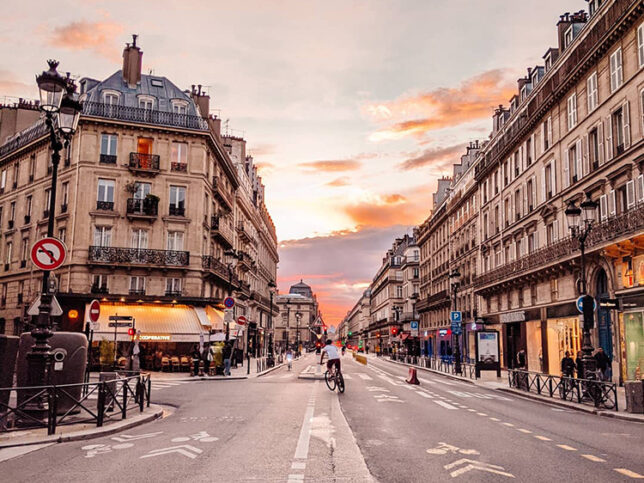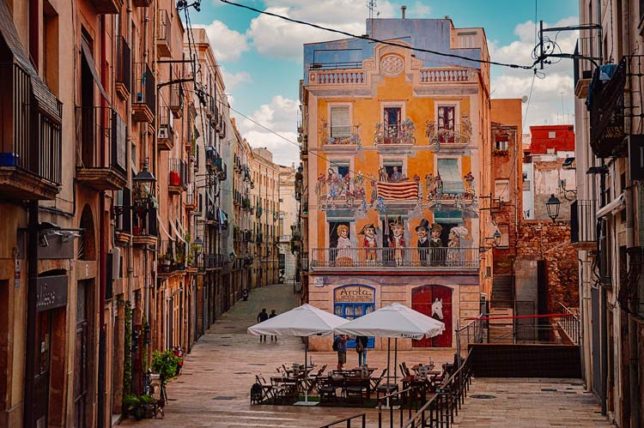Portugal is a stunning country with a rich history and culture. Sharing the Iberian coastline with Spain, this tiny nation is home to some of Europe’s most famous landmarks and attractions. From beautiful cathedrals to picturesque castles and even captivating modern architecture, Portugal is a place that should not be missed. Here are some of the most famous landmarks in Portugal you should definitely visit!
PORTUGAL LANDMARKS IN LISBON
1. Belem Tower, Lisbon
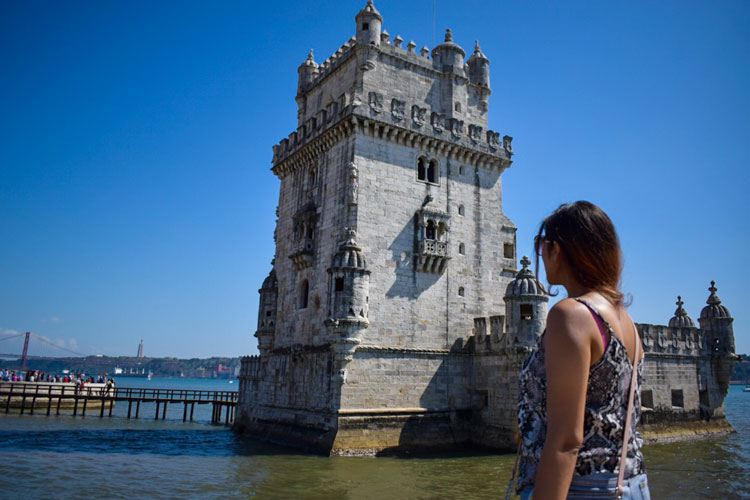
This 16th-century fortified tower is located on the bank of the Tagus River in Lisbon and was built to protect the city from potential invaders. The Belem Tower is one of the iconic structures of Lisbon and a very popular tourist destination.
The tower features several levels each with interesting architectural qualities, such as marble columns, ornate statues, and inscriptions. There’s also a chapel within the tower which houses an impressive painting of the Virgin Mary with child.
The Belem Tower is symbolic of Portugal’s golden age of discovery, a period during the 15th and 16th centuries when maritime explorers would set sail in search of new lands.
It’s a must-visit landmark in Portugal if you want to experience the grandeur of this exciting period.
2. Jeronimos Monastery, Lisbon
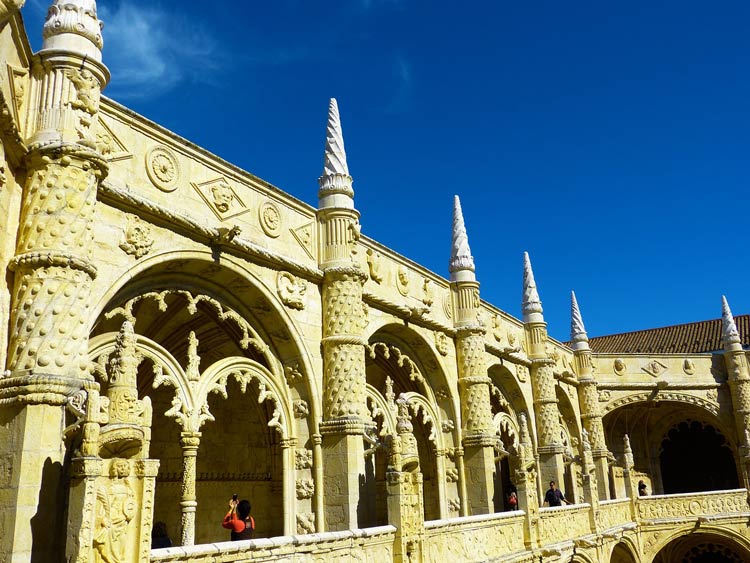
Located a spitting distance from the Belem Tower, Jeronimos Monastery is another important historical monument to complete your visit to Lisbon’s Belem district.
The monastery was built in the early 16th century and is a prime example of Manueline architecture, a style that combines Gothic, Renaissance, and Baroque elements. It is situated next to the launch point of Vasco de Gama’s first explorative journey (where he ended up discovering India). His remains have been buried in the monastery.
Jeronimos Monastery is one of Portugal’s most iconic landmarks and a symbol of wealth from its Age of Discovery.
3. Saint George’s Castle, Lisbon
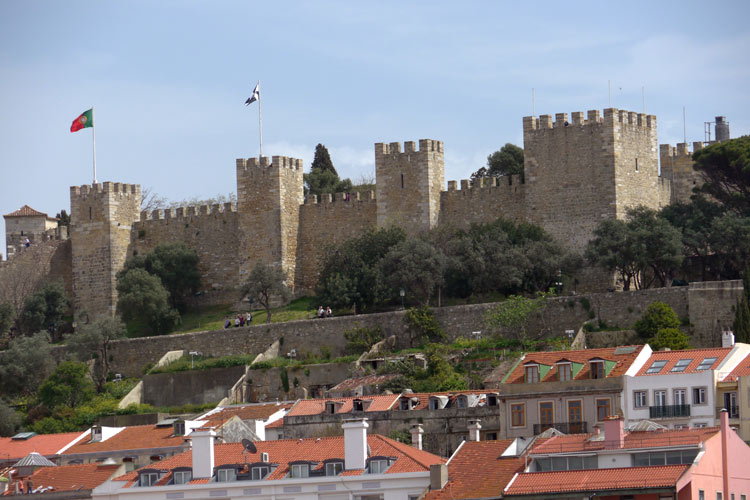
Castelo de São Jorge is one of the most important historical landmarks in Lisbon. It was built on a hilltop, overlooking the city and providing spectacular views of surrounding neighborhoods.
Although the castle is believed to go as far back as at least the 8th century BC, it has undergone several changes over the centuries owing to its occupation under Phoenicians, Carthaginians, Romans, and Moors. In the 12th century, during the Siege of Lisbon, the fortified castle came under Portuguese control.
Inside the castle walls, visitors can explore ancient ruins, winding alleys and a series of defensive towers. The castle complex also features a museum with archaeological artifacts and interactive displays, and a cafe if you fancy a bite. A lookout terraced square outside offers spectacular views of Lisbon.
4. Lisbon Cathedral, Lisbon
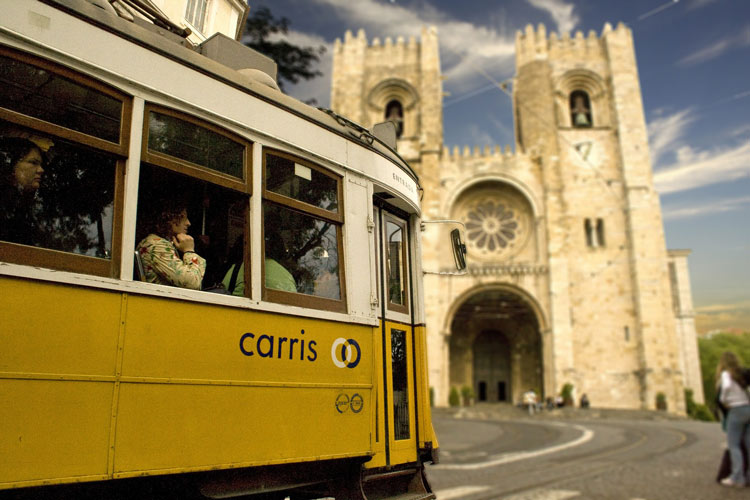
Cathedral of Saint Mary Major, or Lisbon Cathedral, is the oldest church in Lisbon, dating back to 1150. Often simply called the Sé, this exquisite Gothic-style cathedral was built on the site of a former Roman temple.
The cathedral features an impressive rose window and a large central cloister, with its fantastic masonry and beautiful stained glass windows. Inside, visitors can admire the beautiful chapels, tombs, and frescoes that adorn the walls.
The Lisbon Cathedral has survived its fair share of disasters, from the 1755 Lisbon earthquake to the fire in 1959. As a result, the modern-day Sé is a mix of varied architectural styles, making it one of the most fascinating religious landmarks in Portugal.
5. Praça do Comércio, Lisbon
Praça do Comércio is a large public square in the heart of Lisbon, located on the Tagus River. This grand neoclassical square was once the site of a royal palace and has since been turned into an impressive public space.
The square is flanked by beautiful white marble columns and adorned with statues of famous Portuguese kings and explorers.
Take a stroll through the square and admire the magnificent archway and the iconic Triumphal Arch of Rua Augusta, which dates back to 1875.
This plaza is located on the former site of the Ribeira Palace, the residence of Portugal’s kings, which was destroyed in the 1755 Lisbon earthquake.
Notice the covered porticos flanking the square, dotted with street vendors, cafes, restaurants, and office buildings. On the other side, the grand Ribiera waterfront offers a lovely view of the Tagus River and its bridges. Praça do Comércio is one of Lisbon’s best landmarks and a great way to catch the pulse of the city.
6. Ajuda National Palace, Lisbon
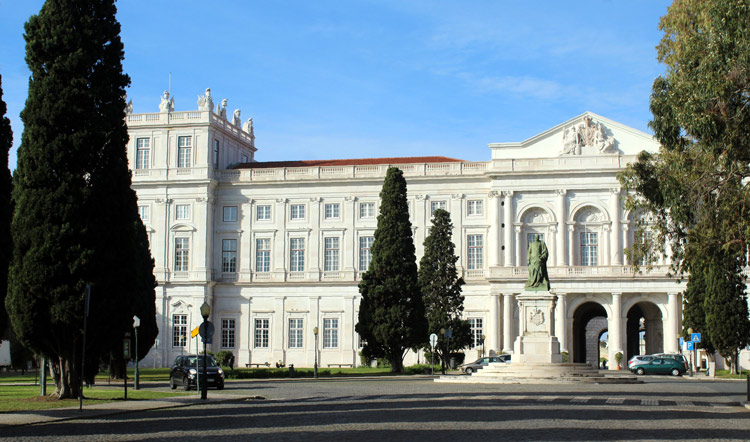
The Palace of Ajuda is one of the grandest monuments in Lisbon, and it’s well worth visiting for its Neoclassical style architecture.
The construction of the palace began in 1796 and was originally intended as a summer residence for Queen Maria I. Eventually, it became the main royal residence of King Carlos I and his successors. The royal family was, however, forced to flee to Brazil during Napolean’s invasion before the completion of the palace.
The exterior is impressive enough, but it’s only when you step inside can you realize the magnificence of the palace. The interior consists of over 60 rooms, each with its own unique style and character. You can find 19th century murals and carpeted floors, tapestries and porcelain sculptures. Every part of the castle is expansive and exudes flamboyance.
The Palácio Nacional da Ajuda is a short drive from Belem Tower. Entry is 5 euros.
7. Santa Justa Lift, Lisbon
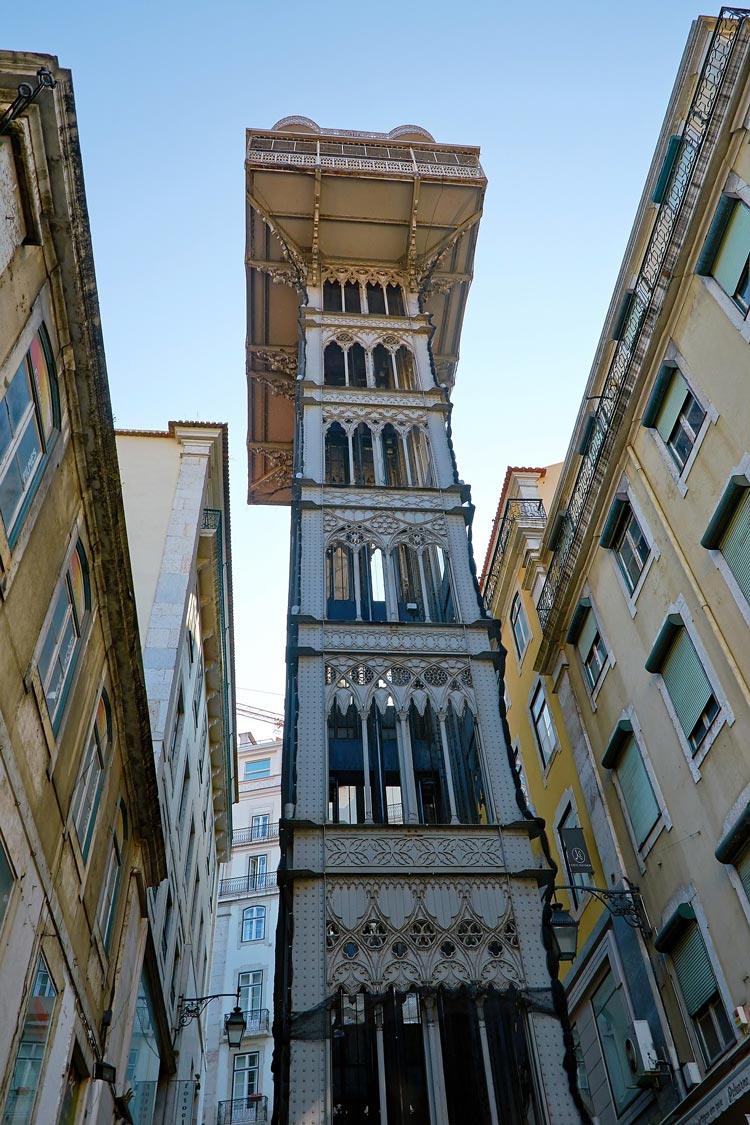
In the heart of Lisbon, you will find one of the most iconic landmarks in Portugal: the Santa Justa Lift. This Gothic-style elevator was built in 1902 to provide access from downtown Lisbon’s Baixa district to the Carmo area and its Convent.
Take a ride up to this 45-meter tall structure for some breathtaking panoramic views of the city. And at the top, you can also admire some interesting details from its intricate architecture.
The Santa Justa Lift is a must-see in Lisbon and definitely one of the most beloved landmarks in Portugal.
8. Monument of the Discoveries, Lisbon

The city of Lisbon is known for its many monuments, and the Monument of the Discoveries is one of them.
Also known as Padrao dos Descobrimentos, the monument stands proudly in Belem at the bank of River Tagus and commemorates Portuguese explorers such as Vasco da Gama, who voyaged to India in the 15th century.
Constructed in 1958, the monument is built in a “ship” shape and is adorned with statues of famous Portuguese explorers. Inside the monument, there is a spiral staircase leading to an observation deck with panoramic views of Lisbon and River Tagus.
If you are curious to learn about Portugal’s “Age of Discovery”, Monument of the Discoveries is a great place to begin.
9. Carmo Convent, Lisbon
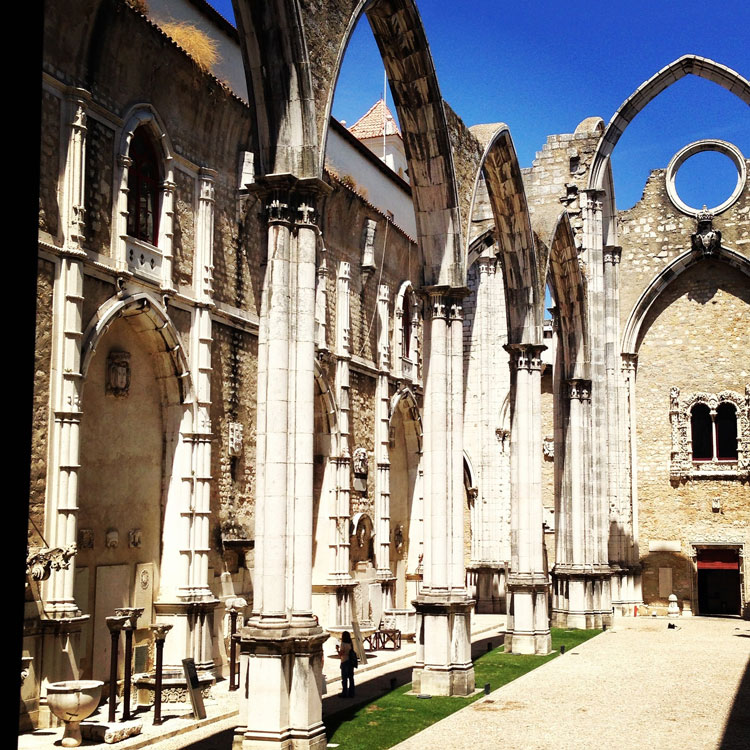
The Convent of Our Lady of Mount Carmel is one of the most famous landmarks in Lisbon. The church was built in 1389 and has since become a symbol of the city.
The convent has a museum home to an impressive and eerie collection of artifacts, including tombs and mummified bodies. There is also an audio tour that covers a brief history of the convent.
The outside courtyard features a cafe and leads you to the back of the Santa Justa elevator (see #7 above).
In the summer, the convent hosts light and sound shows, making it a great place to do something unusual in Lisbon with the family.
When I visited, there was even a resident cat… let me know if you still spot it there 😉
PORTUGAL LANDMARKS IN PORTO
10. Dom Luis Bridge, Porto
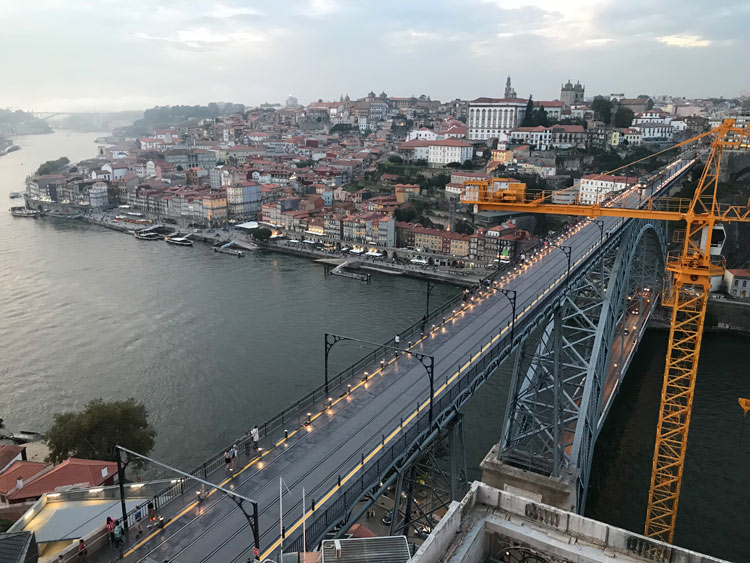
This iconic double-deck bridge was built in 1886 and is an excellent example of late 19th-century engineering. Spanning the Douro River, the bridge connects Porto to Vila Nova de Gaia and offers spectacular views of the cityscape.
The bridge is made up of two levels, the lower being a road and the upper being Porto’s metro rail. Both levels have walkways so it’s a popular spot for visitors to take pictures and admire the view.
11. São Bento Railway Station, Porto

Located in the heart of Porto, São Bento Railway Station is one of the city’s most famous landmarks.
The station was built between 1904 and 1916, and its walls are covered with more than 22000 azulejo tiles depicting historical events from Portuguese history.
The station is a popular tourist attraction, due in part to its beautiful interiors. The grand hall features an impressive high ceiling, with arches and pillars, while the walls are lined with azulejo tile artwork. The tiles depict scenes from the Battle of Valdevez (1140), Portuguese exploration and colonization, and other important events from Portugal’s past.
The polychromatic artwork is a sight to behold, and you can spend hours admiring each detailed panel.
The station also serves as a major transportation hub in Porto, with connections to major cities like Lisbon, as well as Europe-wide connections.
12. Porto Cathedral, Porto
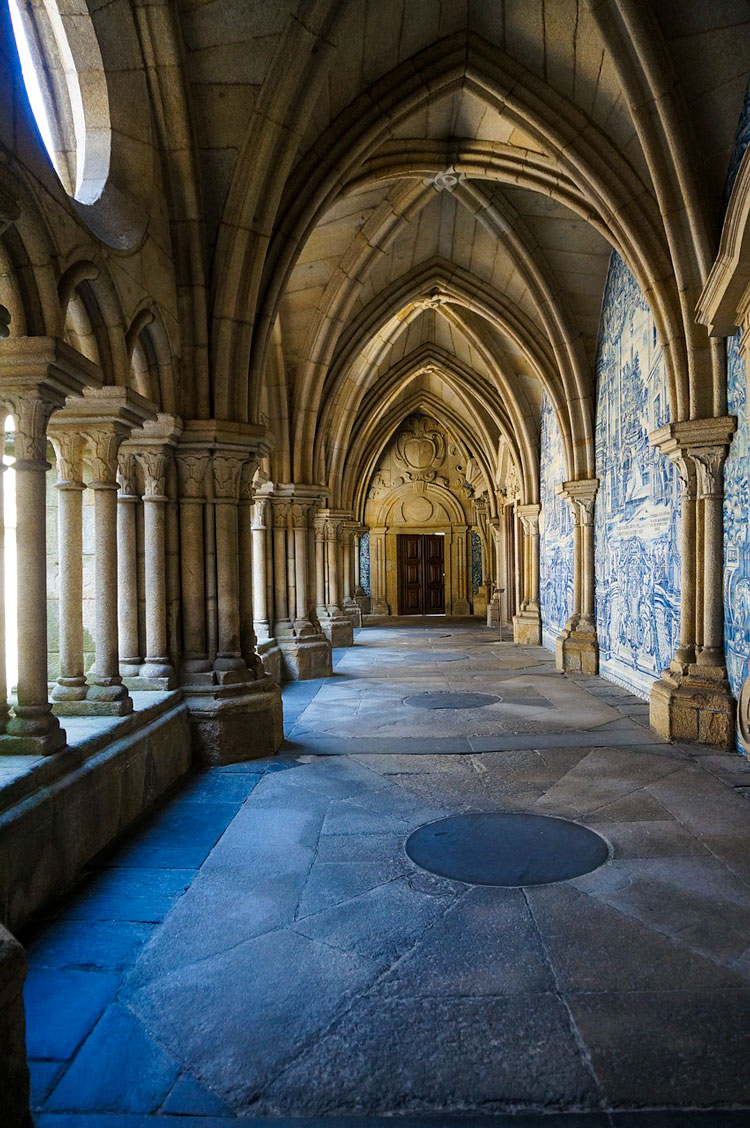
In the vibrant city of Porto, the Gothic-style Sé do Porto stands tall as a monument to Portugal’s long and intricate Roman Catholic history. While the origins of the cathedral date back to the 12th century, the building wasn’t completed until 1737.
The cathedral is an impressive structure, with two square towers supported by buttresses, and a large Romanesque rose window framing the main entrance.
While the exterior is fairly plain, the interiors include striking elements of Baroque. Inside, visitors can find magnificent stained glass windows, chapels and crypts. Additionally, the unique cloister flanked by azulejo tilework really stands out.
PROTIP: You can climb the tower staircase to catch sprawling views of Porto city and the Douro River from the belvedere.
13. Church of St. Francis, Porto
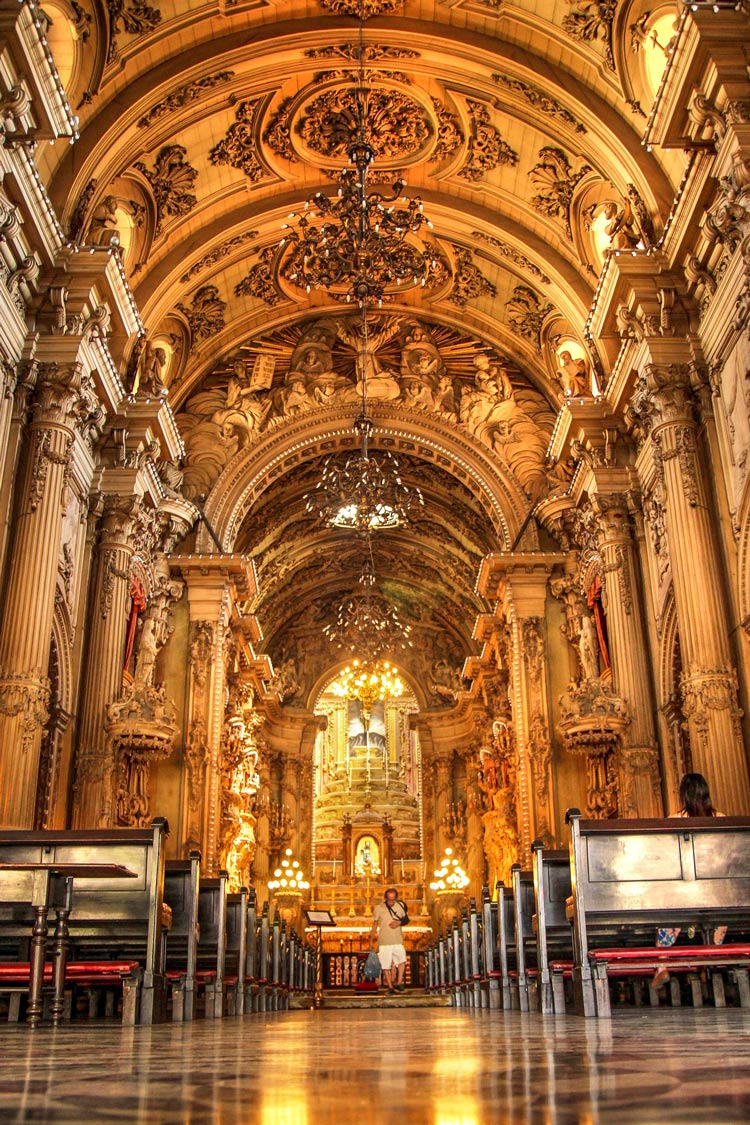
This Gothic style church dates back to the early 13th century and is dedicated to St Francis of Assisi. It is known for its magnificent architecture, which includes an exterior embellished with intricate carvings and symbols and an interior full of Baroque gold-leaf decor.
Church of St. Francis (Igreja de São Francisco) reportedly uses over 400 kg of gold in its interiors, including an elegant main altarpiece and an ornate chapel.
The catacombs holding bones of Portuguese people at the time sits just below and adds an eerie contrast to this gold-studded church.
14. Lello Bookstore, Porto
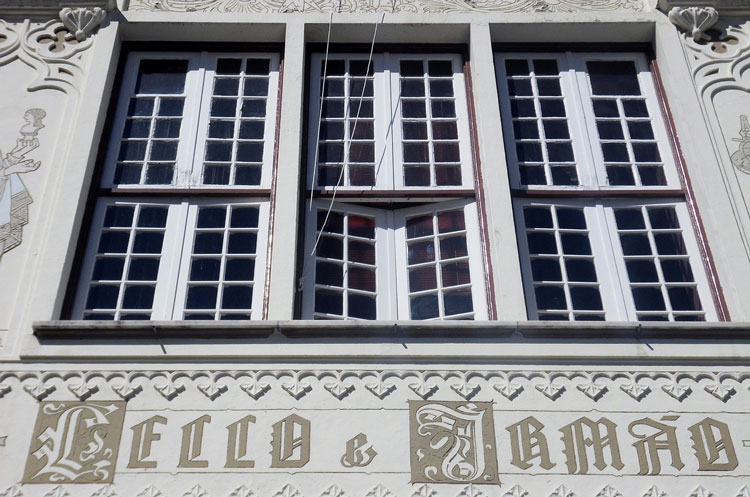
Seeing a bookstore on a list of famous landmarks in Portugal might raise eyebrows, but hear me out.
Livraria Lello, as it’s called, is a bookshop built in a beautiful, old building in the city of Porto and it’s been captivating visitors for over 140 years.
The inside is just as impressive, with intricately carved wooden ceilings and a grand staircase. Story goes that the store was frequented by JK Rowling and was the inspiration behind her work. While that’s not true, the store has many of those grand Hogwarts-like features.
Visiting Lello comes with a fee of 5 euros, but the ticket can be redeemed against a purchase.
HISTORICAL LANDMARKS IN PORTUGAL
15. Obidos Castle, Obidos
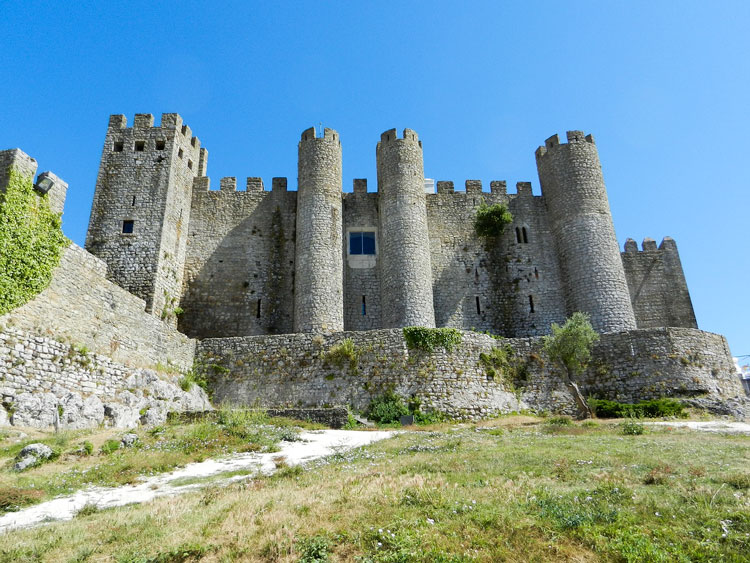
The Castle of Obidos was built in the 12th century and is one of the most well-preserved medieval fortifications in Portugal. It is situated on a rocky hilltop, surrounded by an ancient wall and overlooked by a church.
The Obidos Castle is particularly famous for its annual festivals, such as the Chocolate Festival and Medieval Fair. Visitors can explore the castle’s interiors adorned with typical Portuguese azulejo tiles.
But walking on the castle walls is the best part – you can marvel at the sweeping views of the town of Obidos and the surrounding countryside. Totally worth the hike up!
16. Pena Palace, Sintra
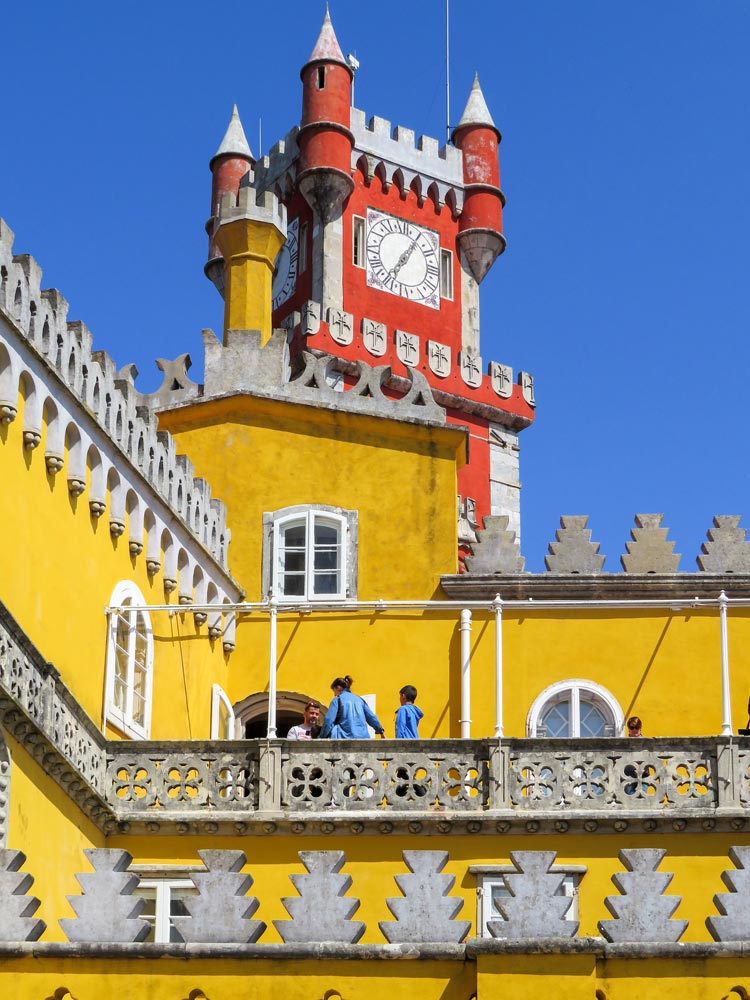
The beautiful Pena Palace is one of the most famous landmarks in Portugal, and unarguably among Europe’s most iconic landmarks. This UNESCO World Heritage Site was built between 1842 and 1854 and is an example of the Manueline, Gothic, and Renaissance styles coming together.
Its unique architecture presents itself in the form of delightful colors, terraces, drawbridges and towers.
The most striking feature of the palace is its vibrant yellow and red exterior which stands out amongst the lush green landscape. Make sure to add this famous monument to your Portugal itinerary.
17. Coimbra University, Coimbra

Coimbra University is the oldest university in Portugal, founded in 1290 and boasting an impressive library with a vast selection of ancient manuscripts. It continues to be a major cultural and educational center and one of the country’s most important landmarks.
The old university campus includes several historical buildings, such as the Joanine Library, a Baroque masterpiece decorated with massive frescos and gilded woodwork.
In 2013, the University of Coimbra was listed as a UNESCO World Heritage Site for its unique cultural significance.
Over its 700 year-history, the university is said to have pioneered Portugal’s scientific and technological advancements.
Whether you’re a history buff or just an admirer of beautiful architecture, Coimbra University is worth a visit.
18. Capela dos Ossos (Chapel of Bones), Evora
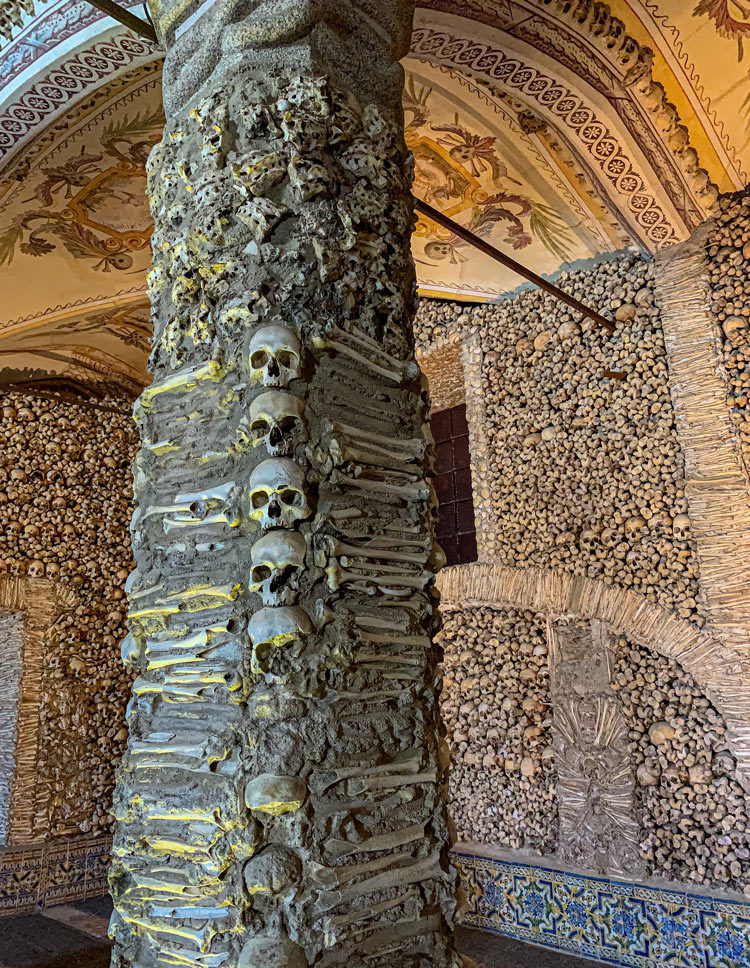
The Capela dos Ossos is an ossuary located in Evora, Portugal and part of the Church of St. Francis. It is estimated that the chapel was built in the 16th century and is made up of thousands of human bones and skulls.
This morbid yet fascinating chapel is decorated with the skeletal remains of monks who practiced in the monastery beside it.
The walls and pillars are lined with 5000 bones and skulls, arranged to create patterns and adorned with an inscription that reads, “We Bones That Here Are, For Yours Await.” The bones and skulls were meant to serve as a reminder of the inevitability of death.
This creepy chapel is a must-see for those looking to experience something unique in Portugal.
19. Quinta da Regaleira, Sintra
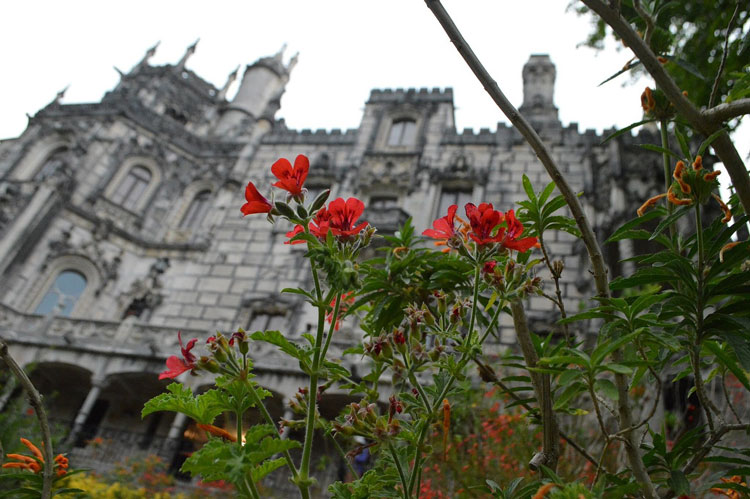
In Sintra, you can find the remarkable Quinta da Regaleira estate. This quinta (literally meaning ‘a large country house) is known for its distinctive architecture, lush gardens and mysterious underground tunnels.
The estate was built in 1904 by a wealthy businessman as a luxurious residence. The manor house features beautiful courtyards, fountains and ornate staircases, while the gardens boast lakes, grottoes, and a chapel.
Explore the palace’s underground tunnels and discover hidden passageways that lead to secret gardens and other mysterious spots.
Quinta da Regaleira is a great example of how Portugal can offer such unique landmarks and experiences to the curious traveler. It’s not to be missed!
20. Monsanto Village, Idanha-a-Nova
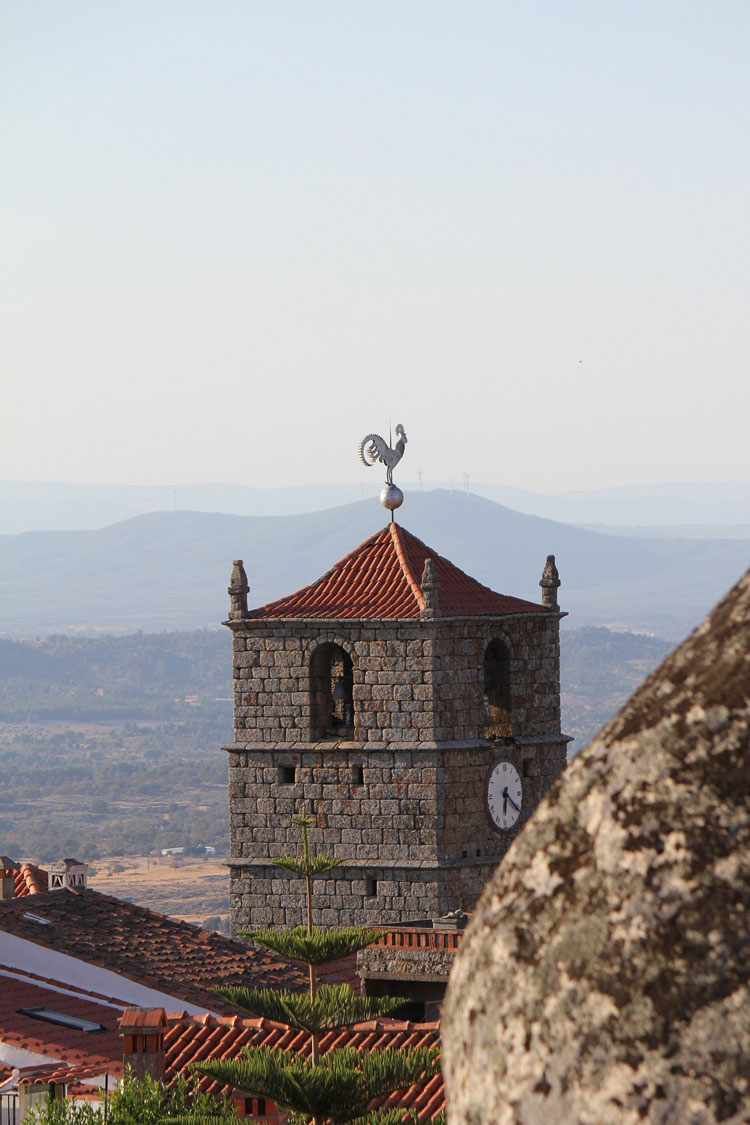
The charming village of Monsanto is situated in the center of Portugal. Its cobbled winding streets, stone houses, and ancient walls make it one of the most idyllic villages in the country.
The village dates back to the 12th century, when it was founded by the Order of Santiago. It is known as “The Most Portuguese Village in Portugal” because of its unique blend of medieval character and modern amenities.
Monsanto features a picturesque castle, a church, many chapels and several cobblestone squares. Take a stroll through the narrow streets of the village and admire its traditional architecture. Enjoy breathtaking views of the surrounding countryside and savor a delicious local meal in one of the village’s quaint restaurants.
Monsanto is an ideal day trip from Lisbon or Porto, and a great way to get away from the hustle and bustle of the cities. Exploring this beautiful village is a special experience when in Portugal.
21. National Palace of Sintra, Sintra
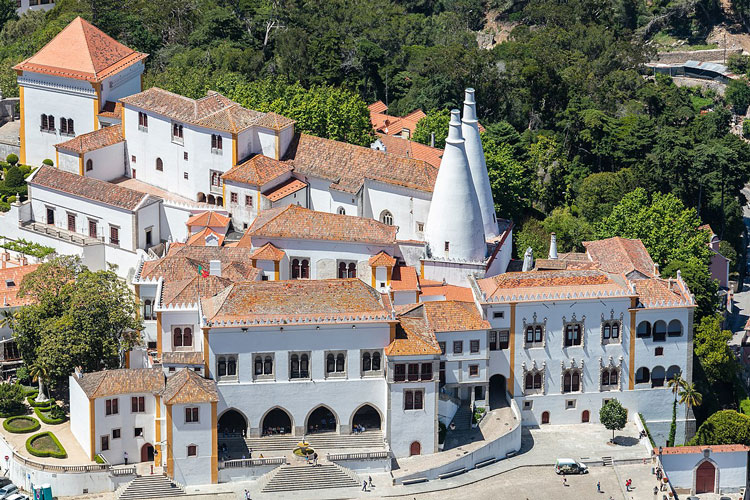
The national palace of Sintra is a great example of Manueline and Moorish architecture in Portugal. Although the earliest reference dates back to the 12th century, the palace underwent major building work in the 15th and 16th centuries.
The interiors feature a mix of Gothic, Mudejar and Moorish styles. Interesting artifacts such as furniture, ceramics and tapestries are on display. Azulejo tilework adorns the walls and celings.
The palace courtyard is surrounded by its iconic twin chimneys, giving it a dramatic look. You can also catch a glimpse of the palace from the nearby Pena Park. A guided tour, preferably with a fast-track entry ticket, is highly recommended to get the most out of your visit.
22. Castle of the Moors, Sintra
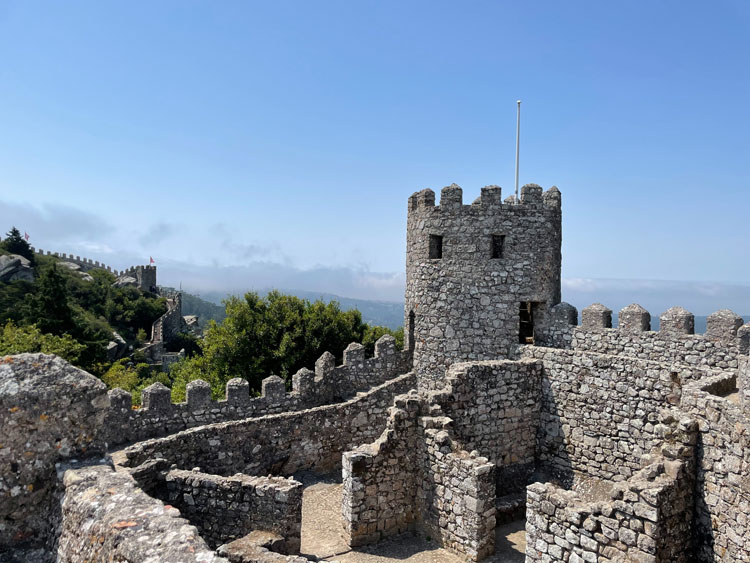
Perched on a hilltop, Castelo dos Mouros is a great location to witness breathtaking views of the architectural paradise that is Sintra.
The medieval castle dates back to the 10th century and was used by the Moors in their strategic defense against the Christian Reconquest of Portugal.
You can climb the castle’s terraced walls for a good view of the town, and it is the perfect spot for taking landscape shots.
Take a guided tour to explore the castle while learning about its history and the fascinating legends surrounding it.
The Moorish Castle is just a short walk from Pena Palace, but you can also take a bus bringing you directly to the castle. Full-day tours from Lisbon will include transfers and entry tickets.
23. Monserrate Palace and Park, Sintra
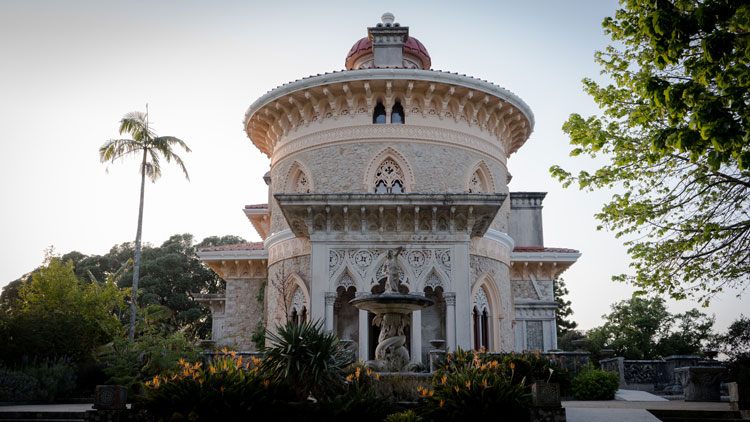
Monserrate Palace and Park is another must-see landmark in Portugal you should visit when you’re in Sintra.
The romantic palace was built in 1863 and has since become an exquisite example of Gothic-Renaissance style architecture. From the outside, the palace looks like a fairytale castle, with its pointed towers and intricate designs.
The grounds are home to acres of lush gardens, featuring over 3000 exotic floral species, waterfalls and lakes.
Monserrate Palace is a popular spot in Sintra and lends itself to many photo ops. Every inch of this sprawling monument is steeped in Romanticism.
Entry to the Palace is 8 euros.
24. City of Guimaraes
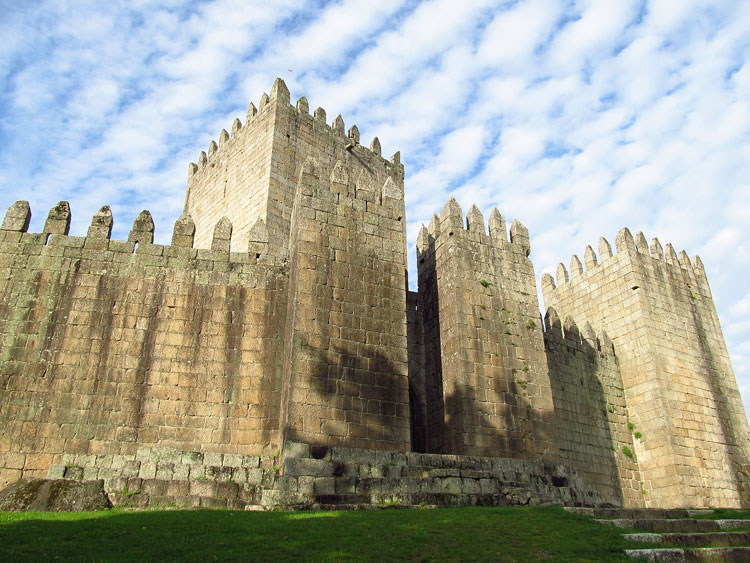
If you like the idea of exploring a town with plenty of history and architecture, then Guimaraes is the place for you. It’s been listed as a UNESCO World Heritage Site and is known as the birthplace of Portugal.
It was here that the country’s first king, Afonso Henriques, was born. Guimaraes also served as Portugal’s first capital.
The main attractions here are its medieval streets and castle, which was built in the 10th century. It’s also home to several churches, monasteries and museums, all worth visiting.
Especially notable are the magnificent Dukes of Braganca Palace and the São Miguel do Castelo Church, a Romanesque masterpiece.
The town center is an ideal place to wander around, with plenty of restaurants and cafes for you to experience Portugal’s local cuisine. Guimaraes is a great day trip from Porto and is easily accessible by bus or train.
Guided tours are also available if you’d prefer to explore with a local expert.
25. Casa de Mateus, Vila Real
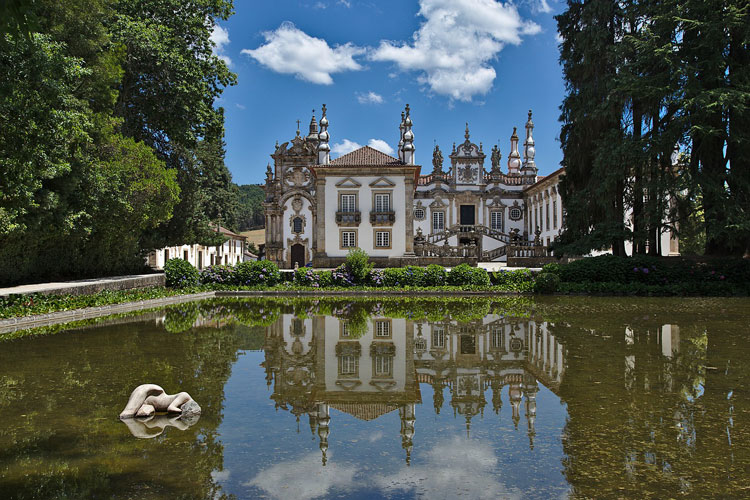
A sprawling 18th-century estate, Mateus Palace is known for its elaborate gardens and neoclassical architecture. The palace is surrounded by a verdant garden with a lake, parterres, sculptures, and fountains, making it feel like stepping back in time.
The manor house is decorated with beautiful tapestries, chestnut wood ceilings, and period furniture. Inside the palace, visitors can explore several highlights such as 17th-century original paintings, the Throne Room, and the library.
The palace also has a wine cellar that is said to have been in use since the 16th century and is now home to Mateus Rose, a popular Portuguese sparkling wine.
Visiting the palace comes with a fee of 10 euros. If you’re feeling fancy, you can also book a private tour which includes wine tasting, guided tour, and a circuit drive in a vintage car.
26. Mafra National Palace, Mafra
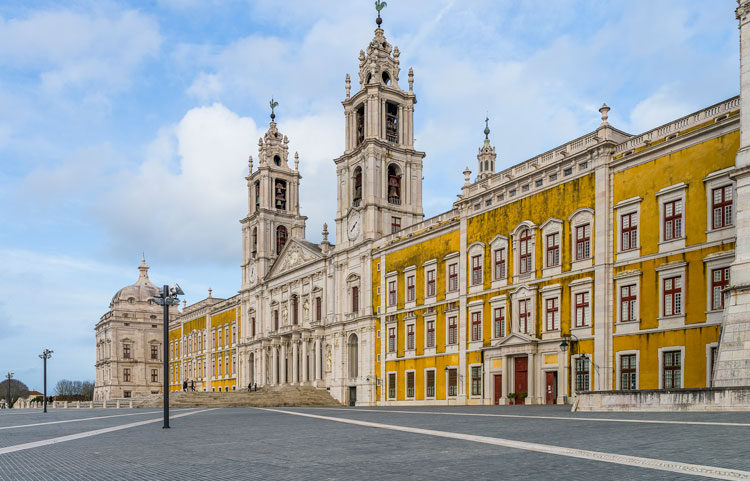
A day trip away from Lisbon, Palacio Nacional de Mafra is a key symbol of the Baroque movement in Portugal. The palace-monastery is an awe-inspiring sight and consists of a convent, basilica, royal chambers and a library.
The Baroque style exterior is a feast for the eyes, with ornate carvings and sculptures. Inside, you can find intricately decorated rooms featuring frescoed walls, grand staircases and pointed arches.
The highlight of the palace is its library which houses over 30,000 volumes printed between the 15th and 19th centuries.
The palace was built on the orders of King John V as a present to his wife for delivering their child. There is also a collection of sculptures, paintings and furniture to admire.
In 2019, the Mafra Palace was inscribed as a UNESCO World Heritage Site.
27. Castle of Santa Maria Da Feira, Aveiro
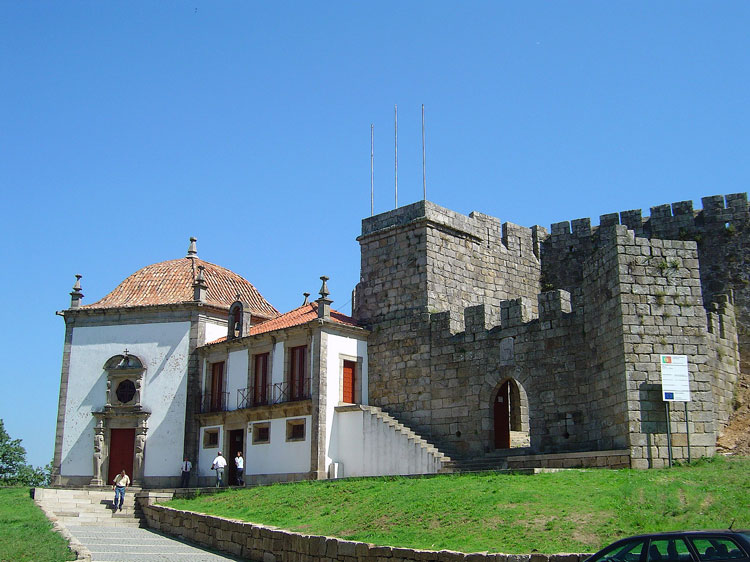
The Castle of Santa Maria da Feira is a medieval castle located in the municipality of Santa Maria da Feira, in the district of Aveiro, Portugal.
It is one of the most important examples of Portuguese military architecture since it still stands today after almost 800 years of existence. Built on a rocky outcrop, the castle is a defensive structure composed of four towers, two courtyards, and an impressive keep.
Visitors to the castle can explore its grandiose walls and parapets and experience a piece of Portuguese history. The entry ticket includes a short film about the castle’s history, which offers perspective as you go about exploring its nooks and corners.
Make sure to wear comfortable shoes and be prepared to climb a fair bit of stairs in the interior. That said, Santa Maria da Feira Castle is an important Portugal landmark and absolutely worth visiting.
28. Cristo Rei Statue (Sanctuary of Christ the King), Almada
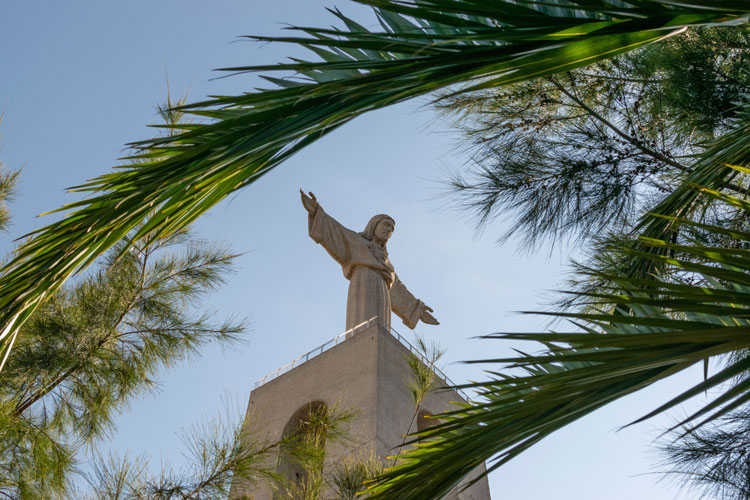
Cristo Rei is a statue of Jesus Christ in Almada, a short ferry ride from Lisbon.
Standing at nearly 25 meters tall, the sculpture is inspired by the Christ the Redeemer shrine in Rio de Janeiro.
The statue was built as a token of gratitude for Portugal being largely spared during World War II. Completed in 1959, the statue overlooks 25 de Abril Bridge and has become a popular destination for devotees and tourists alike.
An entry fee allows you to go to the top where a viewing gallery offers 360 views of Lisbon and the bay. There are also two chapels on the terrace.
RELIGIOUS LANDMARKS IN PORTUGAL
29. Convent of Christ, Tomar

Convento de Christo, or the Convent of Christ, is a religious complex in the city of Tomar. Built in the 12th century, this historic landmark in Portugal has seen its share of history, from the Knights Templar to the Portuguese monarchy.
The Convent is a beautiful example of Manueline architecture, and its unique style can be seen throughout the complex. Its most impressive feature is the large 12th-century round church, with its intricate stonework and ornate decor.
The convent also houses other impressive structures, such as the old refectory, the chapter house, and the eight cloisters.
The main attraction here is the magnificent 16th-century Manueline chapel with its stunning stained glass windows and ornate interior decor.
30. Alcobaca Monastery, Alcobaca
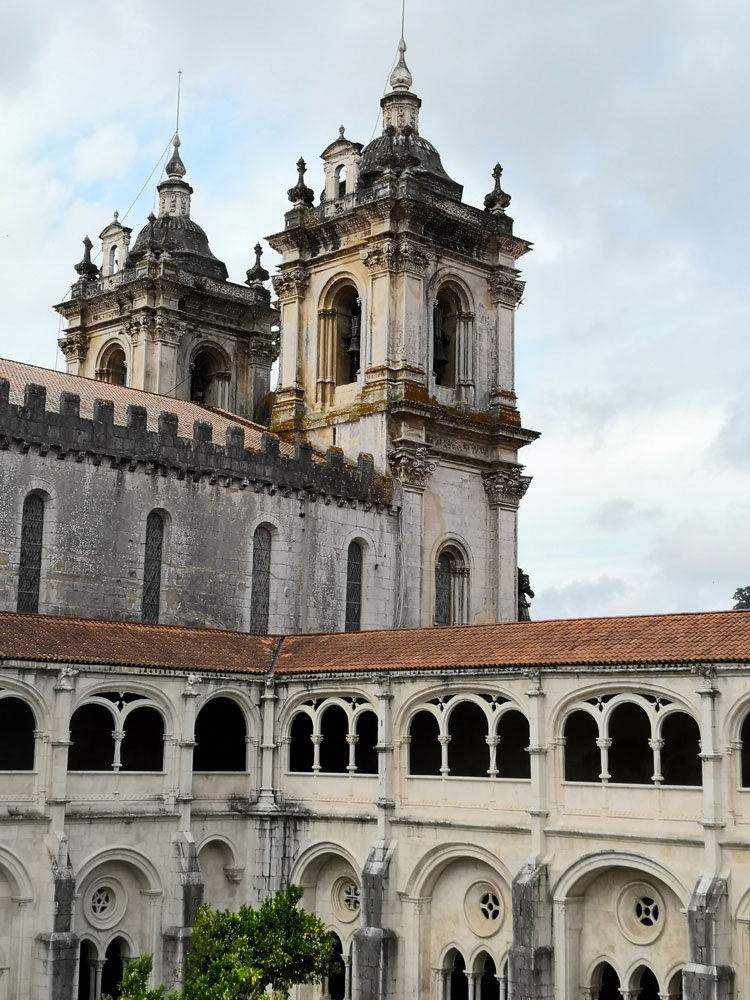
About 120 km from the capital Lisbon, the 12th-century Alcoba Monastery is another important Portuguese landmark.
Alcobaca is a captivating example of Gothic and Manueline architecture, and a true testament to Portugal’s medieval past.
The monastery is surrounded by beautiful gardens and chapel cloisters, with intricate stonework and Romanesque arches. Inside, visitors can find the tombs of King Pedro I and his mistress Ines de Castro, as well as the impressive Gothic-style nave.
The monastery also features a grand library, with a ceiling painted in blue and gold. This is one of Portugal’s most awe-inspiring medieval monuments and a great day trip from Lisbon.
31. Bom Jesus do Monte, Braga
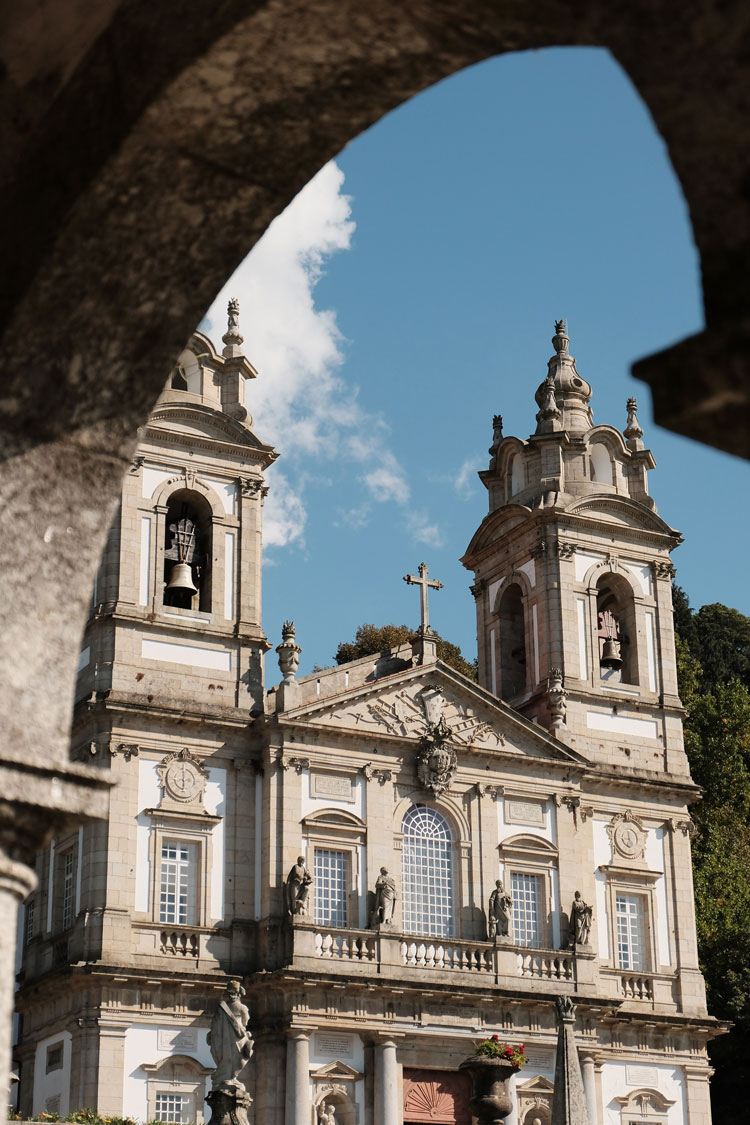
Bom Jesus do Monte is a hilltop sanctuary in the city of Braga.
This UNESCO World Heritage Site has several staircases, fountains, temples, and chapels which lead up to the top of the hill. The ornate Baroque sanctuary is perched atop the hill and can be seen from miles away.
Take a stroll up the steep staircases, made up of 600 steps, and enjoy the breathtaking views over Braga.
At the top, visitors can find a grand 18th-century basilica and beautiful gardens, complete with fountains and sculptures. This is one of Portugal’s most iconic landmarks and a must-visit.
32. Batalha Monastery, Batalha
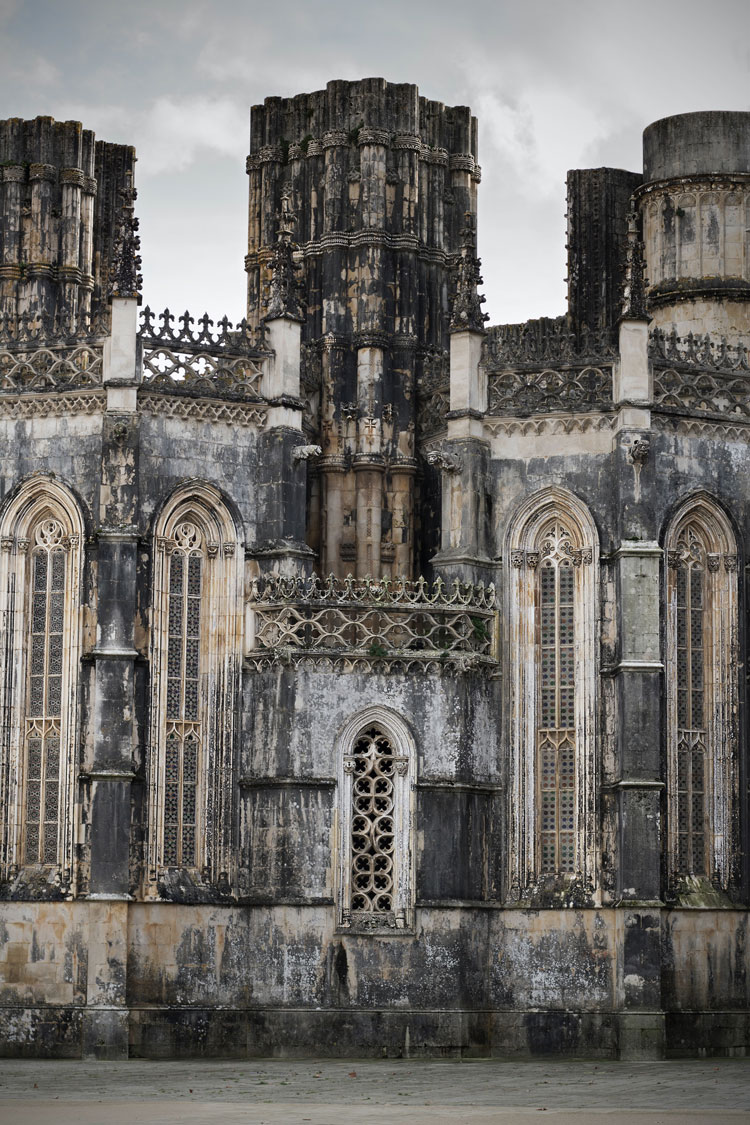
The Batalha Monastery is a beautiful, ancient monastery located in the town of Batalha. This monastery was built between 1388 and 1411 to commemorate the victory at the Battle of Aljubarrota.
The monastery is a UNESCO World Heritage Site and home to several masterpieces of Portuguese architecture. The centerpiece is the incredible six-tier church, featuring intricate designs and artwork depicting religious stories.
Outside the monastery is the extended cloister housing tombs of Portuguese royalty and war heroes.
A fascinating piece of Gothic-Manueline architecture, Batalha Monastery is an important landmark in Portugal and one you must visit.
33. Sanctuary of Our Lady of Fatima, Fatima
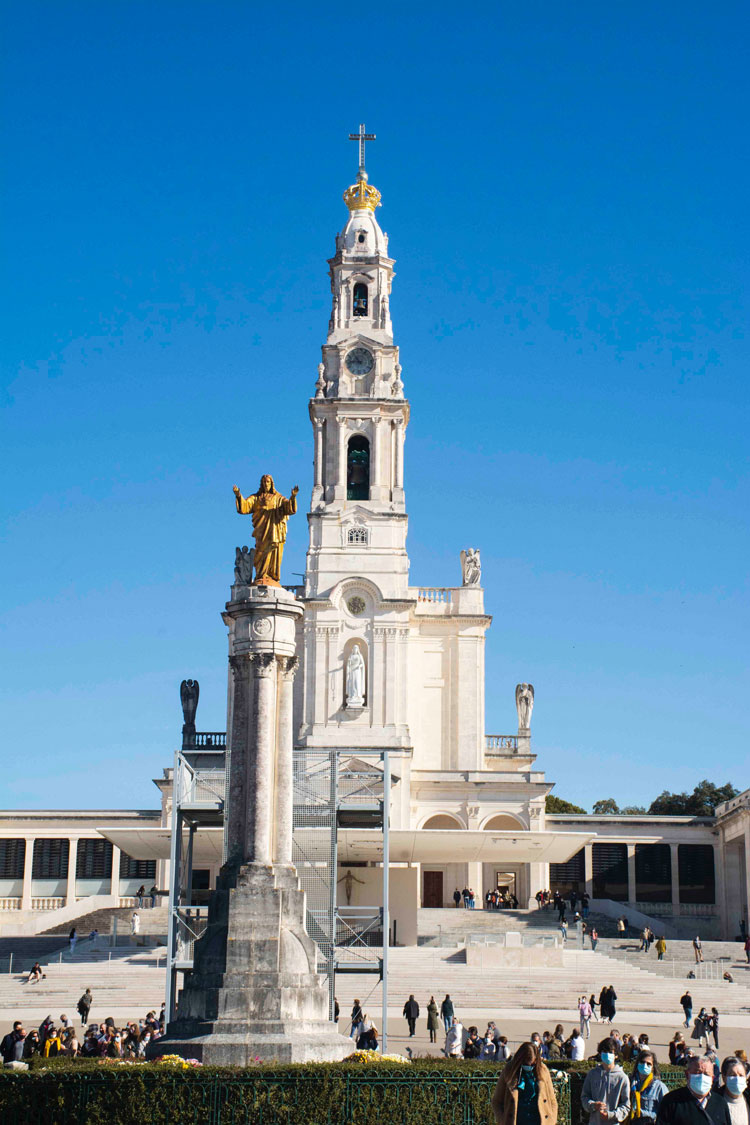
Located in Cova da Iria in Fatima, this is one of the most significant pilgrimage sites for Catholics. The sanctuary was built to commemorate Our Lady of Fatima, the visions of Virgin Mary that three local children had in 1917.
The highlight of the sanctuary is the Basilica which holds a marble statue of Our Lady of Fatima. There’s also the Chapel of the Apparitions, where the visions first appeared, the Chapel of the Lausperene, and other buildings in the complex.
Our Lady of Fatima sits opposite from the comparatively larger Basilica of the Holy Trinity, which was built to support pilgrim services in the sanctuary.
34. Cathedral of Faro, Faro
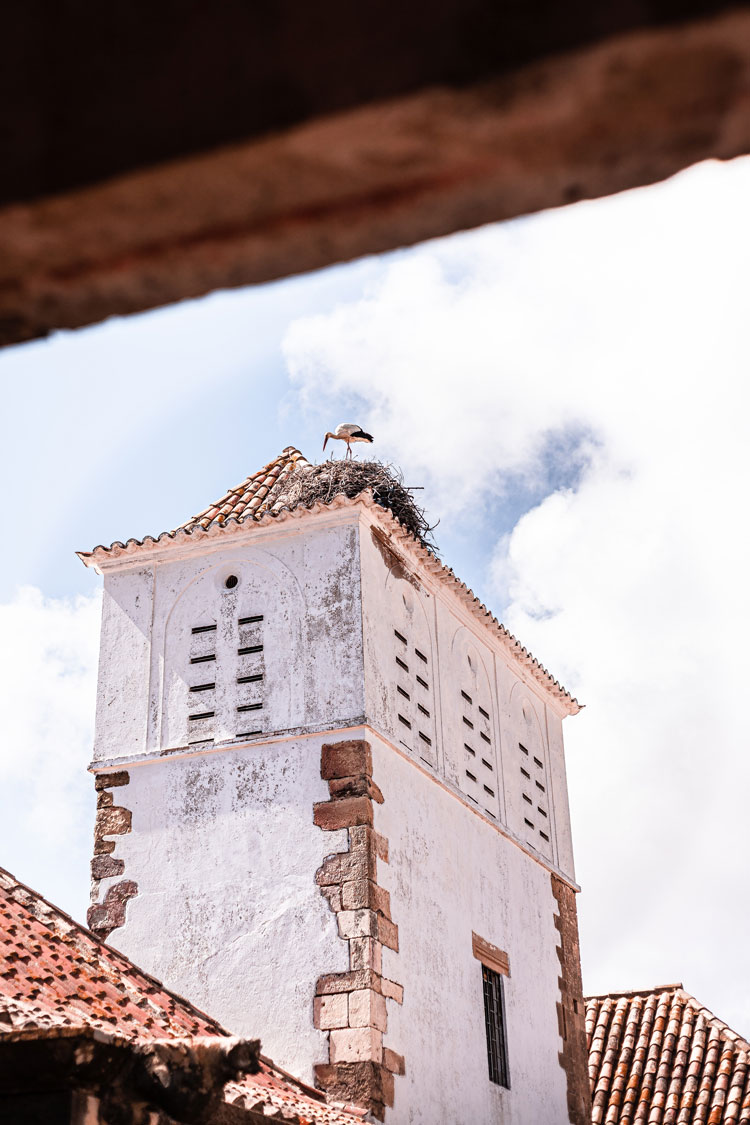
The Cathedral of Faro, or Igreja de Santa Maria, is one of the key landmarks in Portugal. Built in 1251, it houses a unique collection of artifacts including several tombs and religious artworks.
Admire the beautiful tile work that adorns the walls, or explore the bell tower, where you can get a fascinating view of the city and harbor. There is also a small museum set up inside for those interested in learning more about the region and its history.
With its gothic designs and medieval features, the cathedral is truly captivating, I’d say more from the inside than the outside.
There is a small entry fee of 5 euros. The cathedral also has a garden to pause and unwind.
NATURAL LANDMARKS IN PORTUGAL
35. Benagil Sea Cave, Algarve
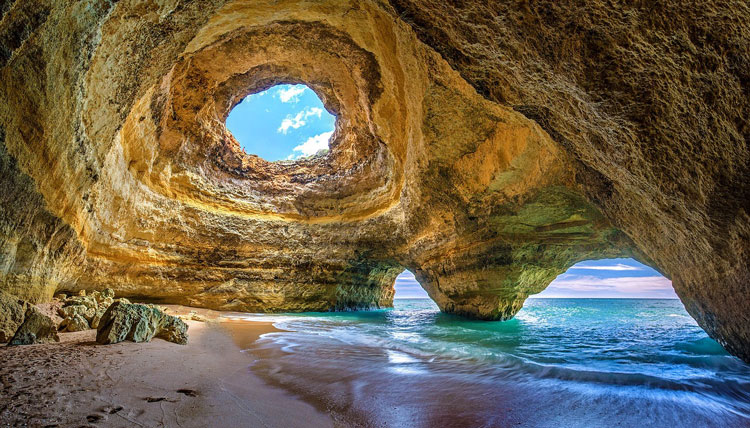
No visit to Portugal is complete without a trip to the Algarve region. Here you’ll find golden beaches, picturesque cliffs, and one of the most remarkable natural landmarks – Benagil Sea Cave.
Benagil is a unique limestone cave that was carved out by the Atlantic Ocean over thousands of years. Its entrance, located on a small beach in Lagoa, is connected to an enormous cavern with a large opening in its ceiling that lets in natural light.
The natural light seeps through the rock walls, illuminating the turquoise waters – creating a magical atmosphere and making Benagil one of the most unique landmarks in Portugal.
A sunrise boat tour is the best way to experience the sorcery that is Benagil. Something about the way the first rays of the sun break through the cave’s contours.
36. Troia Peninsula, Grandola
The Troia Peninsula is located on the south bank of the Sado river and is home to some beautiful beaches. Some of the most popular ones include Praia do Carvalho and Praia dos Galapinhos.
The peninsula’s coastline boasts white sand, blue waters, pine forests and picturesque dunes. Alongside the beach, you’ll find a golf course, a marina for whale-watching, and bike trails. The Roman Ruins and Porto Palafítico are other attractions in the area.
There are lots of restaurants, hotels, and a casino in the peninsula.
37. Douro Valley
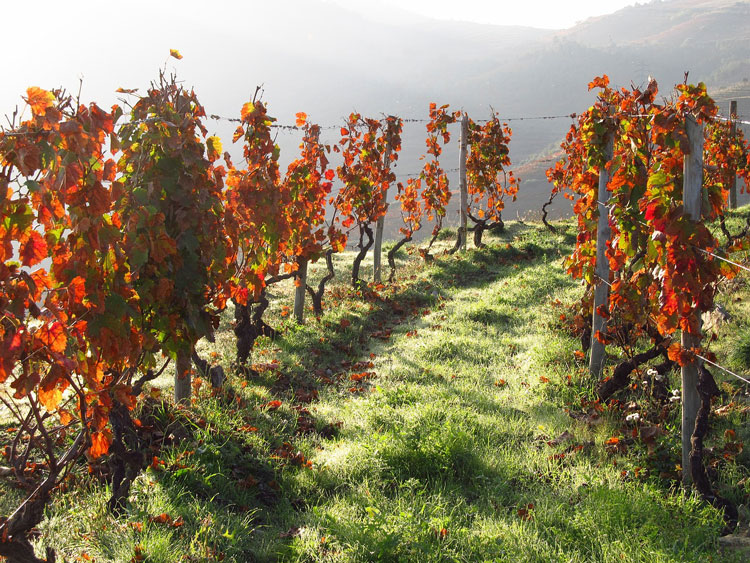
The Douro Valley is one of Portugal’s most celebrated regions and a UNESCO World Heritage Site. Here, visitors can explore beautiful vineyards, terraced hills, and historic villages.
Douro Valley is renowned for its Port wine production. There are plenty of vineyards to explore, including Quinta do Seixo, one of the oldest and most renowned Port-producing estates in Portugal. Take a tasting tour, and sip on the sweet and delicious dessert wines with the expansive countryside in the background.
Take a cruise down the Douro River, or explore one of the beautiful medieval villages, such as Pinhao and Vila Real. The natural landscapes, historic monuments, and expansive views of the Douro make it one of Portugal’s most famous natural landmarks.
38. Berlenga Grande, Berlengas
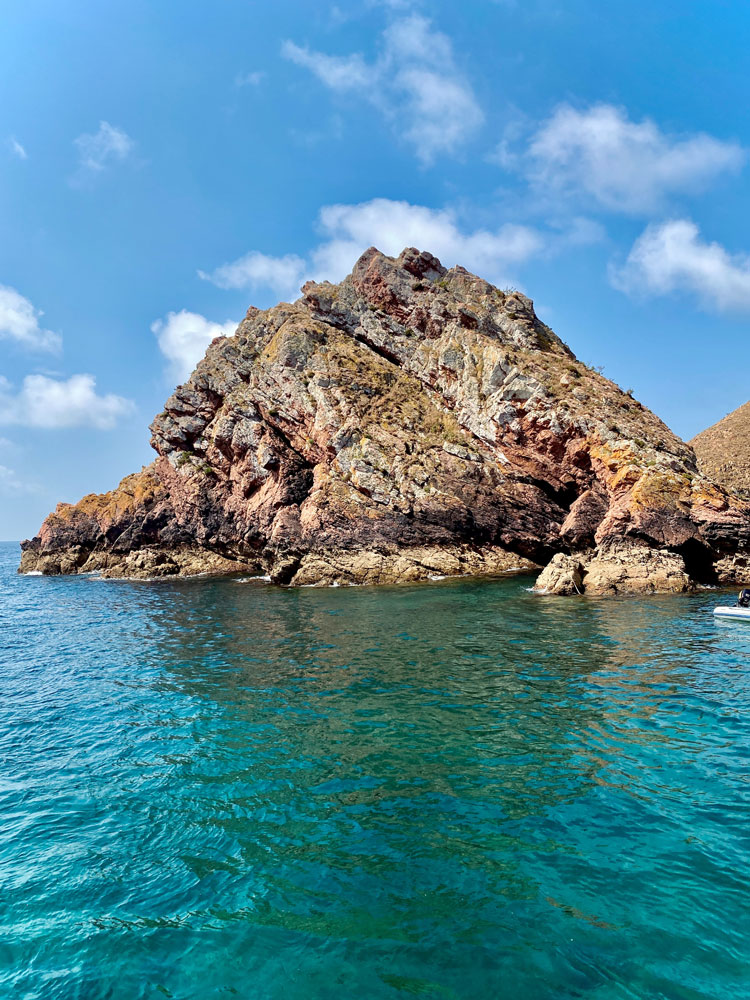
Off the coast of Peniche lie the Berlengas, an archipelago composed of three small islands and several islets. The archipelago is a nature reserve, a haven for rare seabirds, wild goats, and unique plant species.
Its largest island, Berlenga Grande, features impressive beaches and lush vegetation.
Some of the things you can do on the island include basking in the breathtaking views of Portugal’s west coast, snorkeling and scuba diving, and relaxing in one of the many secluded coves.
The island also features attractions like the São João Baptista Fortress, and the Berlengas Lighthouse.
Plan a day trip to the Berlenga Grande from Lisbon and get a chance to experience this jewel of the Portuguese coastline.
39. The Azores

The Azores are an archipelago located in the middle of the Atlantic Ocean, and an autonomous region of Portugal. It is known for its picturesque scenery, including vast green meadows, lush valleys, and volcanic islands.
Think of it as a paradise for nature lovers and adventurers alike. The islands offer an abundance of activities such as whale and dolphin watching, diving, hiking and cycling. You can get close to nature and explore the many lagoons, waterfalls and beaches. There are also plenty of cultural sites to explore such as churches, chapels and old castles.
The islands of the Azores, especially Faial, Sao Miguel and Terceira, serve a diversity of experiences, from the beaches and hot springs of Furnas to the rugged cliffs of Pico.
This unique destination definitely tops the list of Portugal’s most beautiful natural landmarks.
40. Mount Pico, Azores

The highest mountain in the country, Mount Pico is a majestic natural landmark in Portugal. Located on the island of Pico, this imposing stratovolcano rises to an elevation of 2351 meters.
Challenge yourself and climb the mountain, if you’re feeling adventurous, although with a qualified guide, to experience incredible views of the surrounding islands.
If you’re like me, though, you can still enjoy the landscape by taking a drive along the mountain’s slopes.
There are also several things to do on the island itself, from exploring Portugal’s largest lava tunnel, the Gruta de Torres, to visiting UNESCO vineyard sites at Criação Velha.
41. Marinha Beach, Algarve
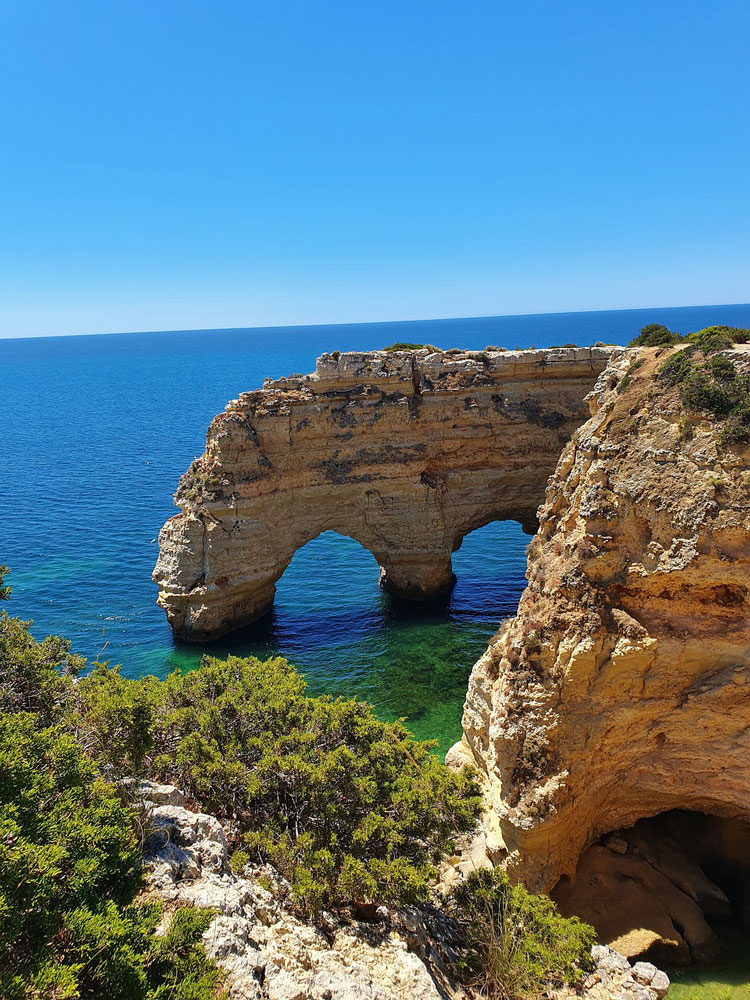
Located on Algarve’s southern coast, Marinha Beach is one of the most famous landmarks in Portugal.
This beach has a unique landscape with its towering red rock cliffs and crystal waters, making it a favorite for photographers.
You can explore the nearby caves or just relax on the shore and enjoy the incredible views. With its crystal-clear waters and golden sand, it’s no wonder Marinha Beach is ranked among the 25 most beautiful beaches in the world.
42. Cape St. Vincent, Algarve
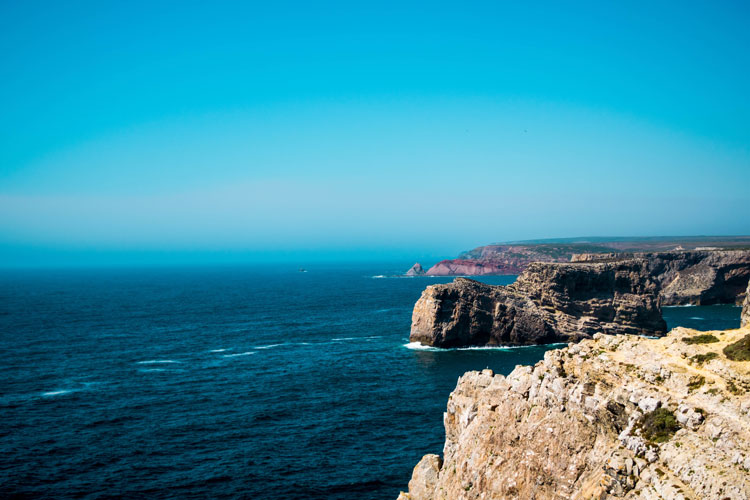
Sitting at the southwestern tip of Portugal, Cape St. Vincent (Cabo de São Vicente) is one of the most picturesque landmarks in Portugal. It’s painted with wild cliffs, golden sand dunes, and endless views of the Atlantic Ocean.
The cape was considered a sacred spot by the ancient Romans who called it the Land’s End and believed it to be an entrance to the underworld. It was also an important landmark for early sailors and is still considered one today.
Surrounding the cape, you will find several historical sites such as the Fort of São Vicente, where ancient battles were fought. The nearby Sagres Point is also worth a visit; it’s home to a fortress and a lighthouse.
Visiting Cape Vincent is a must if you are looking for breathtaking views and interesting landscapes in Portugal.
43. Praia da Costa Nova, Aveiro
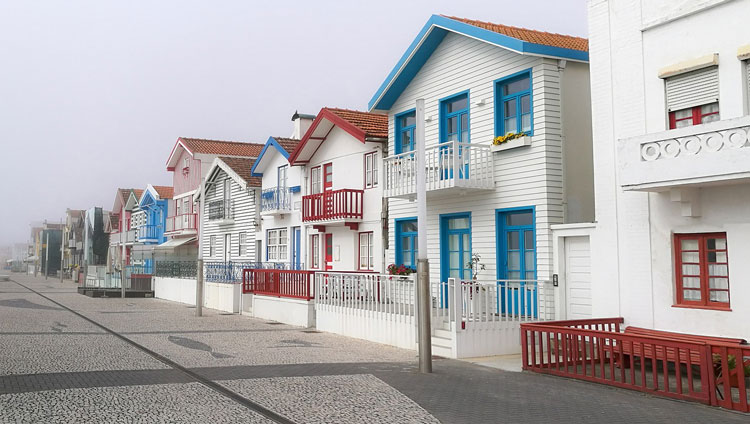
Easily one of Portugal’s most idyllic beaches, Costa Nova has a beautiful shoreline lined with traditional multicolored fishermen’s huts.
These colorful homes, known as “palheiros“, are a combination of wood and traditional tiles, painted in bold stripes of bright colors.
At Costa Nova you can enjoy a variety of activities such as surfing, stand up paddleboarding, or simply taking a stroll along the beach.
The estuary nearby adds to the location. A 6 km walkway connects the beach to Costa Nova and offers scenic views along the way.
Praia da Costa Nova makes for a great day trip from Porto or Aveiro, and is the perfect place to relax, take in the scenery, and enjoy a picnic in the sun.
44. Peneda-Greres National Park, Northern Portugal

Perfect for an outdoorsy escape, the Peneda-Gerês National Park is an important natural landmark in Portugal’s north. This protected area covers an impressive 70,000 hectares and is filled with lush forests and wild rivers.
Geres is Portugal’s oldest and only national park. It borders Spain and offers a unique landscape marked by waterfalls, granite outcrops and megaliths.
Hike the trails of the national park, go camping in the Geres mountain range, or admire the wildlife. In this natural paradise you can also visit historical landmarks such as Castro Laboreiro, a village where you can still find ancient dwellings and granaries.
Whether you’re looking for an adventure or just some good ol’ nature, Peneda-Geres is a wonderful option.
45. Cabo da Roca, Sintra-Cascais Natural Park
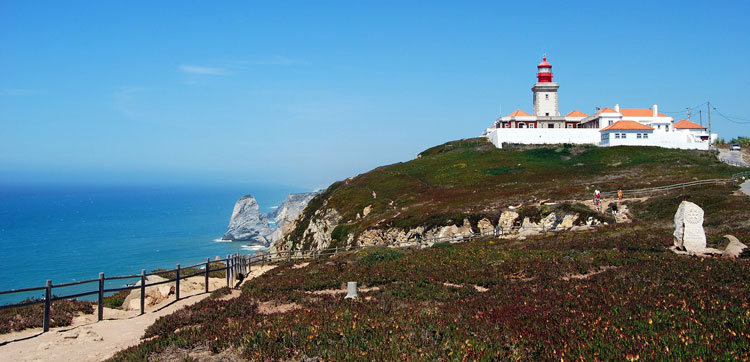
Cabo da Roca is a cape located in the lovely Sintra-Cascais Natural Park.
This rocky edge marks the western-most tip of mainland Europe and offers sprawling views of the Atlantic Ocean.
Standing tall at an elevation of 140 meters, the shore of the cape has been a popular tourist attraction for years, and it’s easy to see why. A lighthouse prominently stands on the edge and has become a symbol of the cape.
The site can be reached by taking a train to Cascais or Sintra, followed by a bus to Cabo da Roca. Once here, you can admire the extraordinary views of the sea and feel a true sense of privacy surrounded by nature.
46. Ponta da Piedade, Lagos
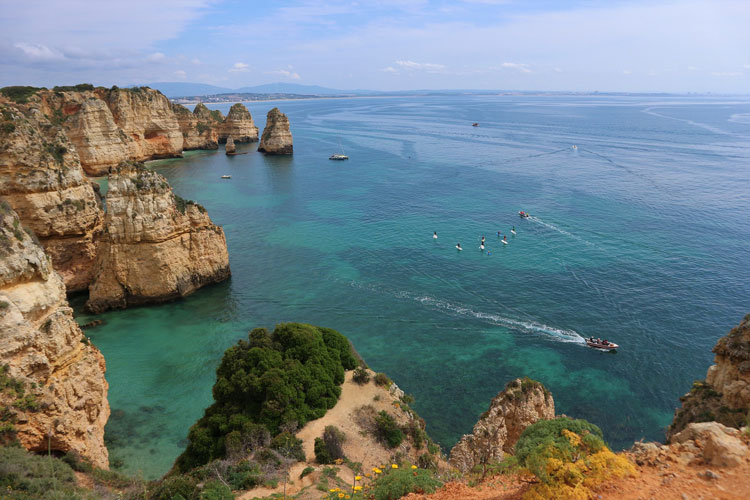
Located in the coastal town of Lagos, the Ponta da Piedade headland is a marvelous natural gem in Portugal. Its rocky coastline is filled with marvelous natural grottos, yellow-golden cliffs and coves.
Explore the many lagoons and upto 20-meters high rock formations, or take a boat tour to get closer to the action. The views have been described as spectacular and the area is a great spot for watching the sunset.
Literally meaning “Piety Point”, Ponta da Piedade affords crystal clear waters perfect for a swim or snorkel. The area is also home to a few secluded beaches, where you can relax under the sun and admire the natural beauty that Portugal has to offer.
47. Pico Ruivo, Madeira
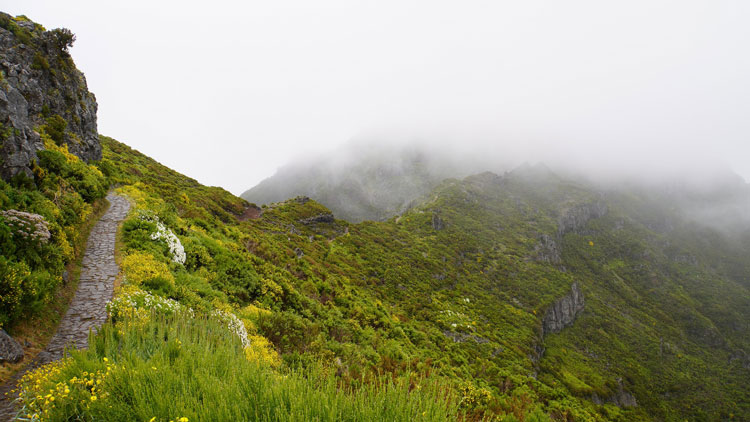
On the beautiful island of Madeira, you’ll find one of Portugal’s most important natural landmarks.
Pico Ruivo is Madeira’s highest mountain peak and stands at an impressive 1862 meters.
The mountain is a popular hike destination, and you can take the Pico do Areeiro or Pico Ruivo trails to reach the top. The views from the summit are breathtaking and you can even see small islands in the distance.
The hike is challenging but in a good way, as you can admire the unique flora and fauna along the way. The trail is open all year round and worth visiting any time.
48. Ria Formosa Natural Park, Olhao
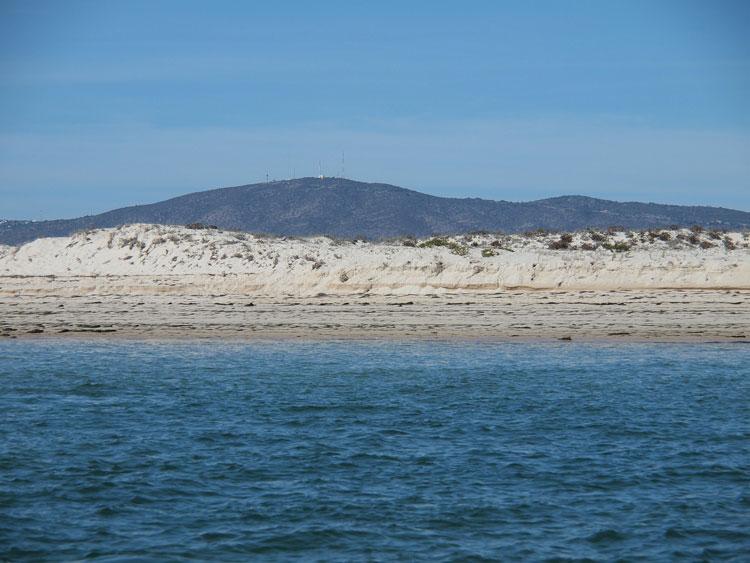
Ria Formosa is an extensive natural park on the Algarve coast. It’s a haven for birds and wildlife, making it a popular spot for birdwatchers. The park is also great for hiking, cycling, and kayaking.
Boasting a wide range of natural landscapes, including beaches, lagoons, salty marshes, and sand dunes, it’s no surprise that Ria Formosa is one of the most popular landmarks in Portugal.
The islands of Culatra, Armona, and Tavira can all be found in the park and are great destinations for a weekend trip from Lisbon.
FINAL THOUGHTS ON THE MOST FAMOUS PORTUGAL LANDMARKS
Portugal is a vibrant, diverse country with a rich history and culture.
From historic sites to natural landmarks, Portugal offers something for everyone. I love the country especially for its beautiful beaches, grand palaces, traditional villages, and the chance to sample some fine Portuguese wine 😉
If you get the opportunity to visit this spectacular country, be sure to refer back to this list of the top landmarks in Portugal!



